
When talking with a new client, landscaping for privacy is at the top of most people’s wish list.
Whether the need is to screen neighbors who are a tad too close, obscure an offending garden eyesore or create a secluded courtyard in the front garden, like in the photo (left.)
When it comes to gardens, people want their privacy!
Over the years, I’ve helped people create privacy using either plants or structures (or both!) and have seen loads of other gardens where homeowners have developed their own creative solutions.
So in today’s post, I’ll break these solutions into two main categories – screening with structures and screening with plants.
1. Privacy with Structures
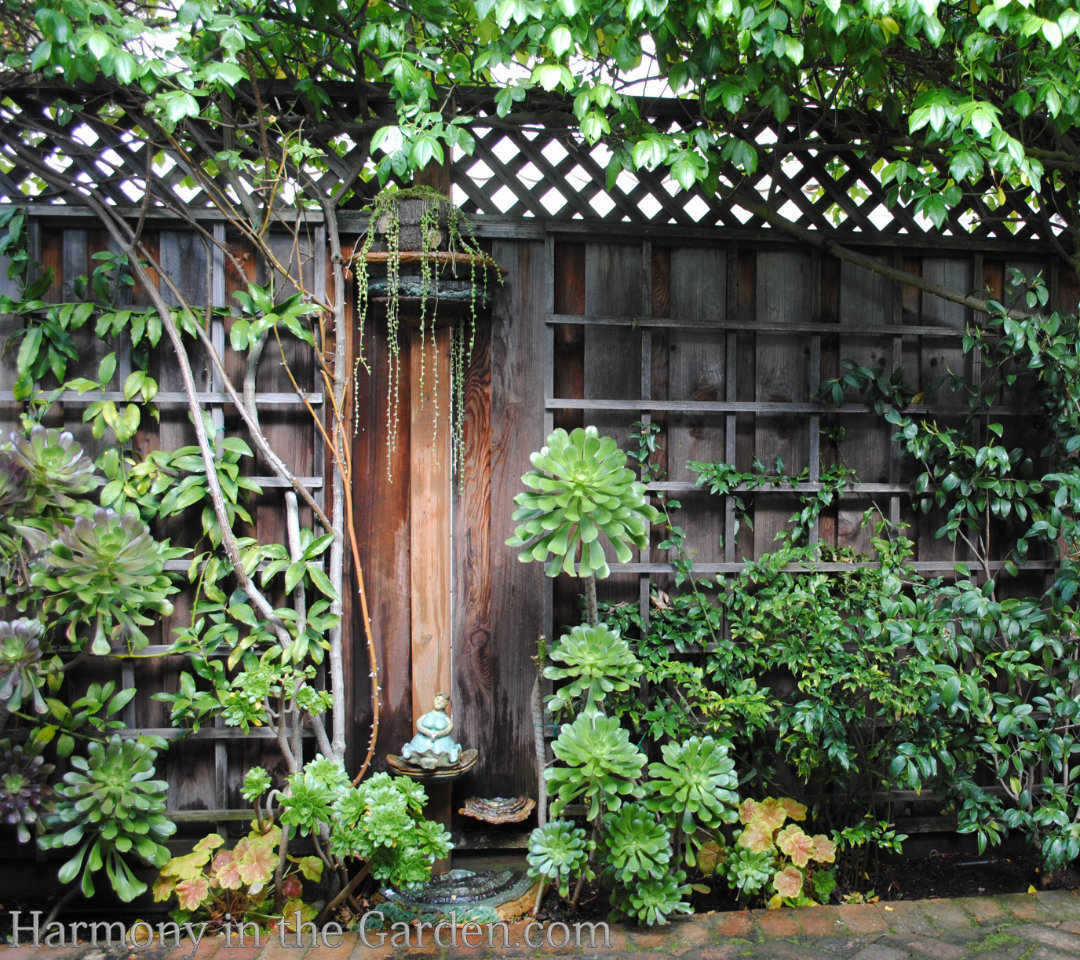
Let’s start with the simplest structure – a trellis added to the top of the fence.
To add a few extra feet to the top of a standard wooden fence, sometimes the simplest thing is to add a trellis to the top of the fence.
It’s easiest to plan for this initially when installing the new fence, but it is possible to modify an existing one.
Just make sure the ultimate height is within your city’s ordinances, and double-check that your neighbor is okay with any changes you’d like to make.
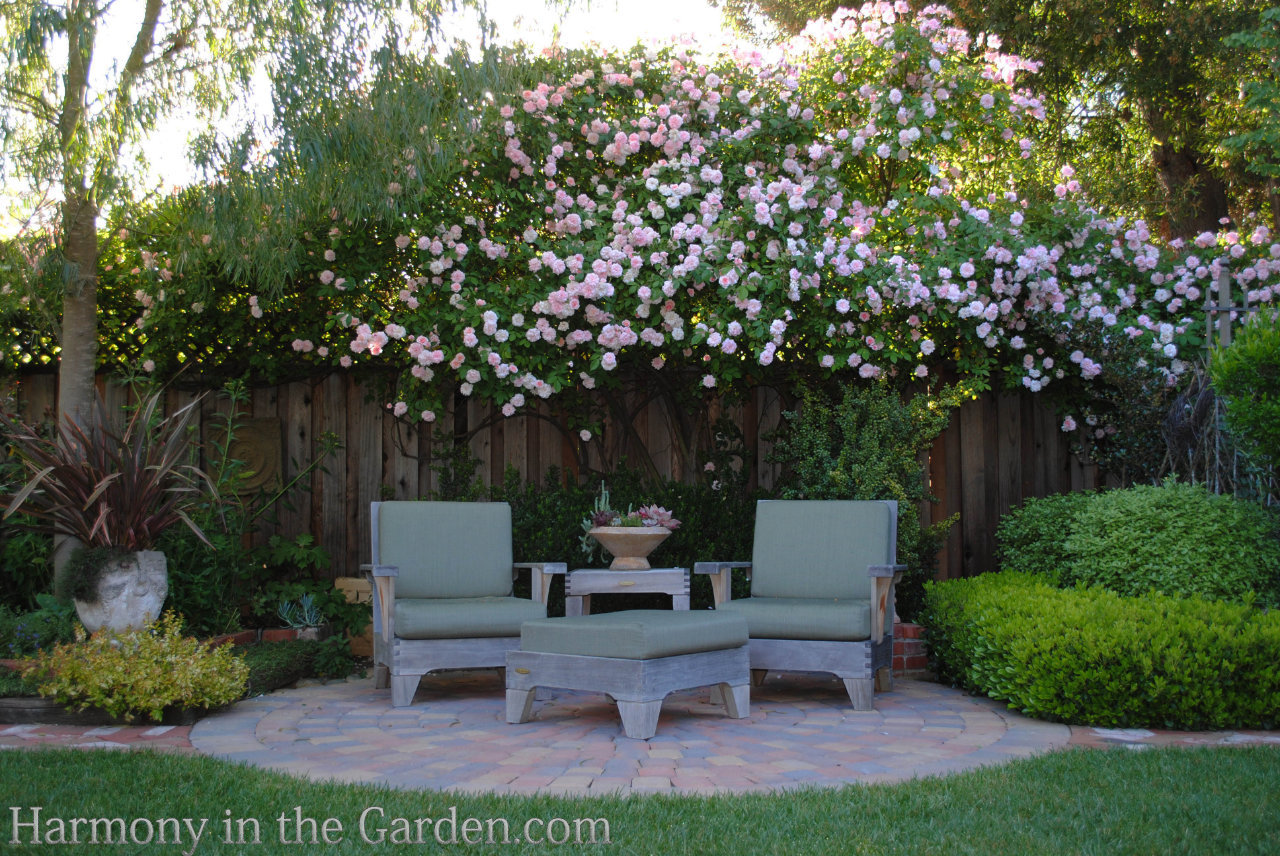
Climbing roses are one of my go-to climbers to plant long fences.
With age, the strong structure of the rose supports the plant while allowing the long stems to be trained along the side and top of the fence.
This ‘Cecil Brunner’ rose, for example, grows at least 15-feet in both directions along the fence, not only adding eye-candy blooms but also providing several additional feet of screening.

I did the same thing on this side yard fence, using a ‘Sally Holmes’ rose (left.)
Over the years, several long canes were strategically trained to grow an additional 3’ above the trellis, adding even more height for screening.
As a side note, the blooms that would cascade over the fence were very much appreciated by the neighbor, too! Plenty of cut flowers for everyone.
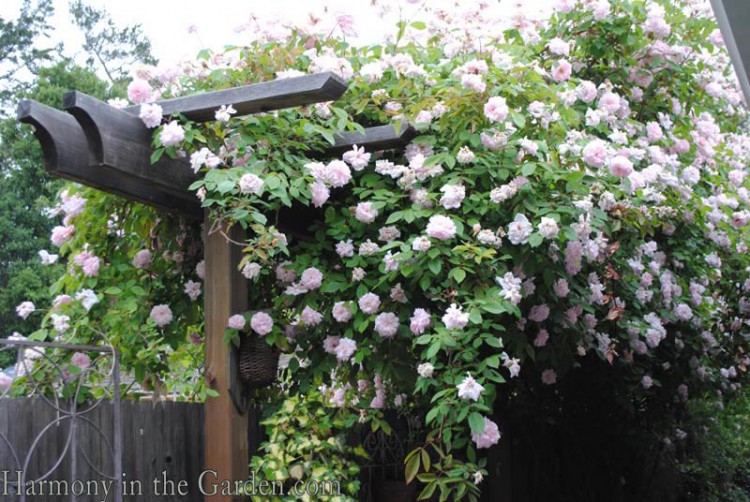
One of my favorite trellis solutions is one that my husband and I built in this skinny side yard.
The idea originated when a new neighbor decided to remove all the trees from their backyard, exposing their unsightly roofline and tons of hot summer sun.
The neighbor didn’t want us to attach a trellis directly to the fence, so we built a free-standing trellis placed along the fence.
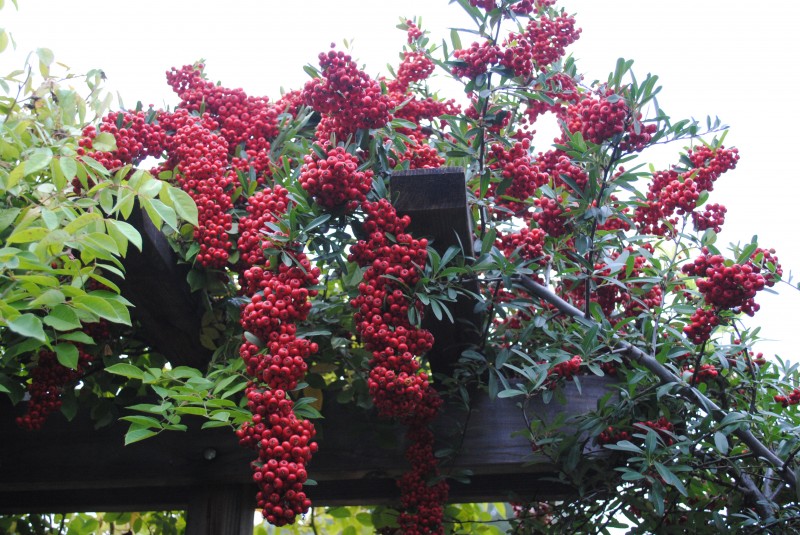
The added height provided a structure for a climbing rose on one end, and espaliered pyracantha bush on the other.
I especially love the clusters of red berries that hang through the trellis (almost as much as the robins and waxwings do!)

The freestanding trellis was such a successful solution, we decided to build another one (this time painted black) in a different part of our garden.
I planted an evergreen clematis cirrhosa ‘Wisley Crème’ to delicately scramble up and over one end of the trellis.
And on the other end, I planted the evergreen clematis ‘Avalanche’.

This are two of my favorite varieties of clematis, as they’re not only evergreen (evergreen, people!) but have very different bloom times.
The ‘Avalanche’ blooms in the late spring through mid-summer, while the ‘Wisely Creme’ (left) blooms in the late fall through winter. Yes, I said late fall through winter!
And while the clematis vines don’t provide as much blockage as the ‘Cecil Brunner’ rose, this area only needed the feeling of enclosure and privacy (versus screening an unsightly view.)
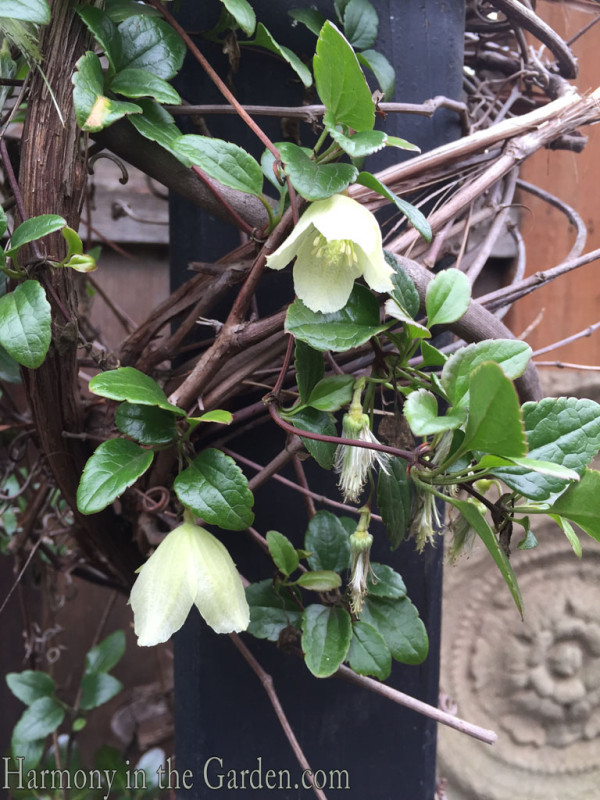
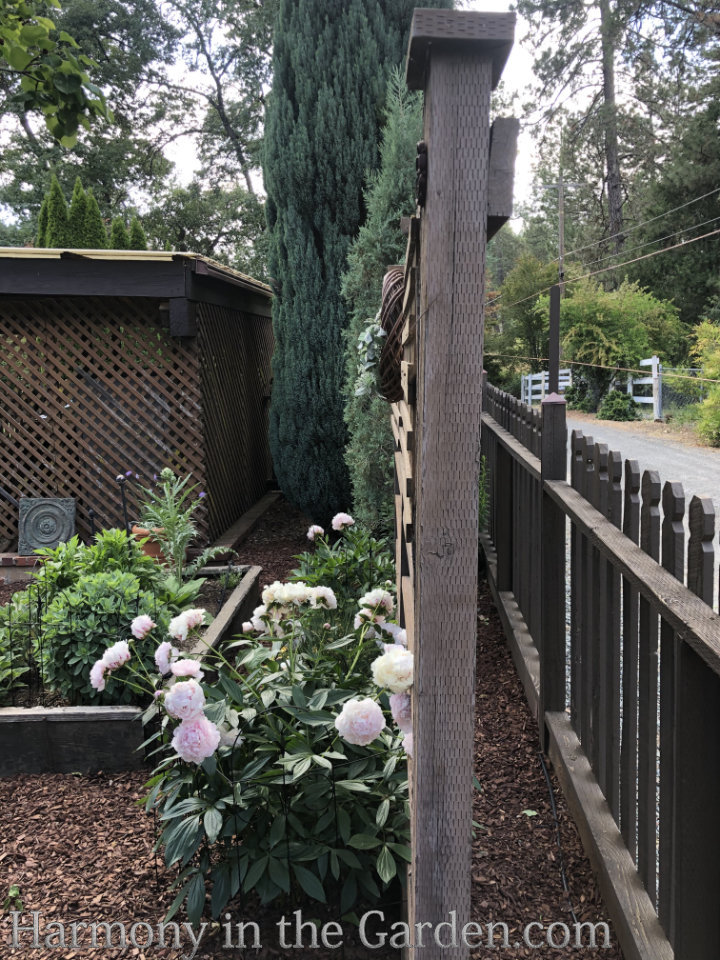
Here’s another example of a free-standing trellis that my father built for the vegetable garden.
A familiar scenario occurred: the neighbor’s tall hedge was removed, creating a new focal point – an unsightly roofline.
Thanks to the trellis, there’s plenty of screening, as well as support for climbing edibles, an ornamental vine, or in this instance, a seasonal wreath.
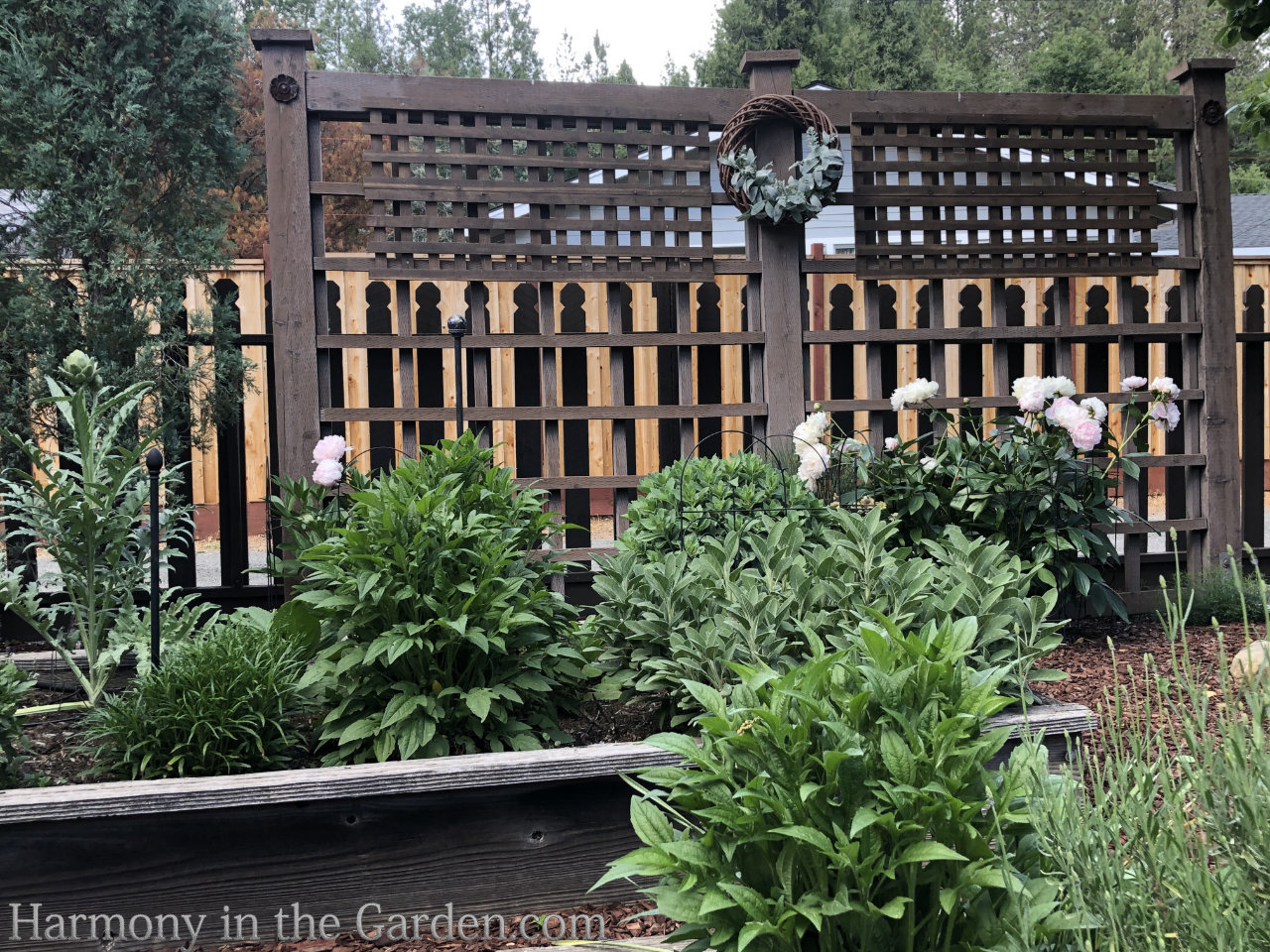
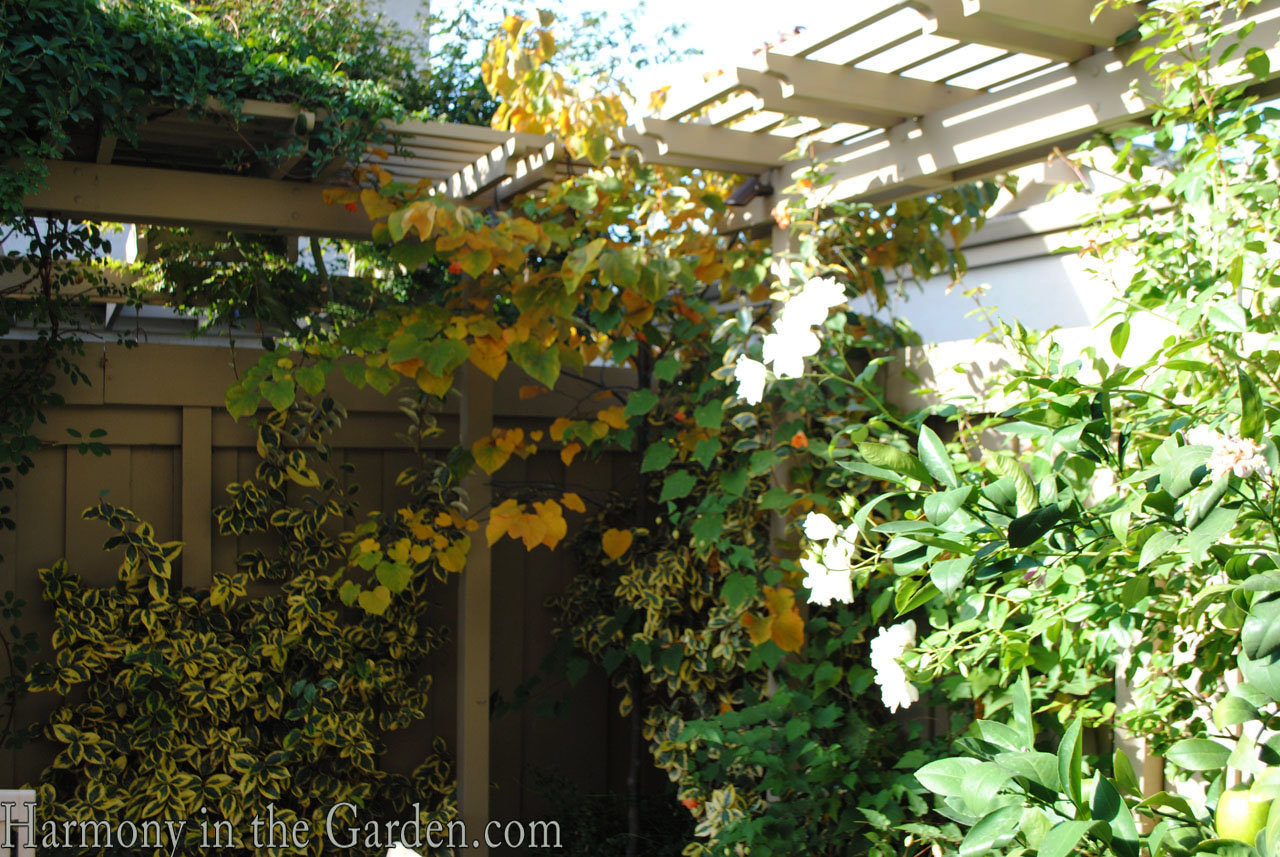
This courtyard garden is governed by HOA rules which don’t allow for anything to be attached to the fence.
Our solution was to build this L-shaped free-standing trellis. The trellis not only screens the neighboring home, but also supports an ‘Iceberg’ climbing rose and akebia quinata vine.
Click here to read more about this sweet garden.


While on a recent garden tour, I spotted this skinny pergola strategically placed within this narrow garden bed to create a sense of privacy from neighbors.
Brilliant!


A similar concept was created by Freeland & Sabrina Tanner.
In their gorgeous garden (click here for some jaw-dropping inspiration) they created semi-private screening from their neighbors.

When using lattice for screening, various levels of privacy are achieved through the spacing between slats of wood. Less space, less privacy (and visa-versa.)
In this example, screening was needed between the back garden and the front street, yet a solid gate would’ve felt too oppressive for this small courtyard garden.
The open spaces of the gate provide plenty of privacy while still allowing a peek beyond, which helps create a more open feeling.
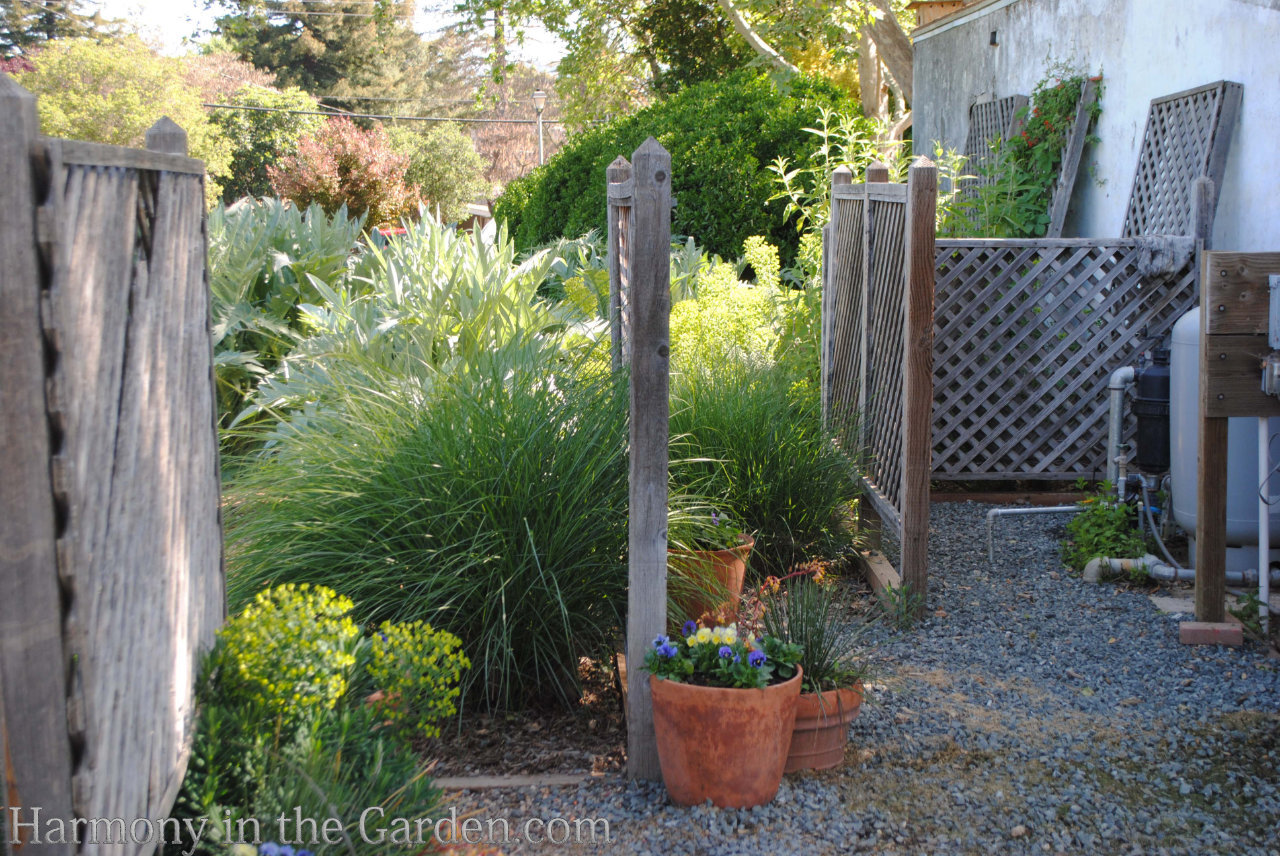
While visiting the gardens of The French Laundry, I discovered these handy trellises, placed in a slightly staggered position.
The reason they’re placed this way is to provide screening for the employees who are working behind the screens, prepping freshly picked veggies, etc. while maintaining the garden’s open, informal feeling.
Click here to read more about my visit to this garden.

Sometimes all that’s needed is the illusion of privacy to help define an intimate space within a much larger area.
A few years ago my husband and I stayed in this wonderful AirbNb that had this incredible, sprawling country garden.
Several intimate garden rooms were created within this large space with clever use of upcycled antique doors, windows, etc.

As the ‘walls’ of this garden rooms illustrate, sometimes just the illusion of screening is all that is needed to create a private atmosphere.

This is a simple idea, stringing decorative objects (capiz shells comes to mind!) and use them to create the illusion of privacy.
Sure, you can still see through the space, but it’s enough to create a sense of enclosure.
Plus, it’s so sweet and versatile. The sky’s the limit when it comes to what type of objects you could use!

Here’s another example of the illusion of privacy created using antique windows and an airy structure.
2. Screening with Plants
Sometimes plants alone can provide plenty of privacy, eliminating the need to buy or build a trellis, fence, or gate. One of my go-to small trees is the prunus caroliniana ‘Bright ‘n Tight,’ a moderate growing tree to 10’ x 6’ in 10 years.
I often use the standard version (standard = removing the lower limbs to create a ‘tree’ shape), which allows additional planting underneath the canopy. In small spaces (like side yards) this is an ideal strategy, as the different ‘layers’ of planting gives the illusion of more space.
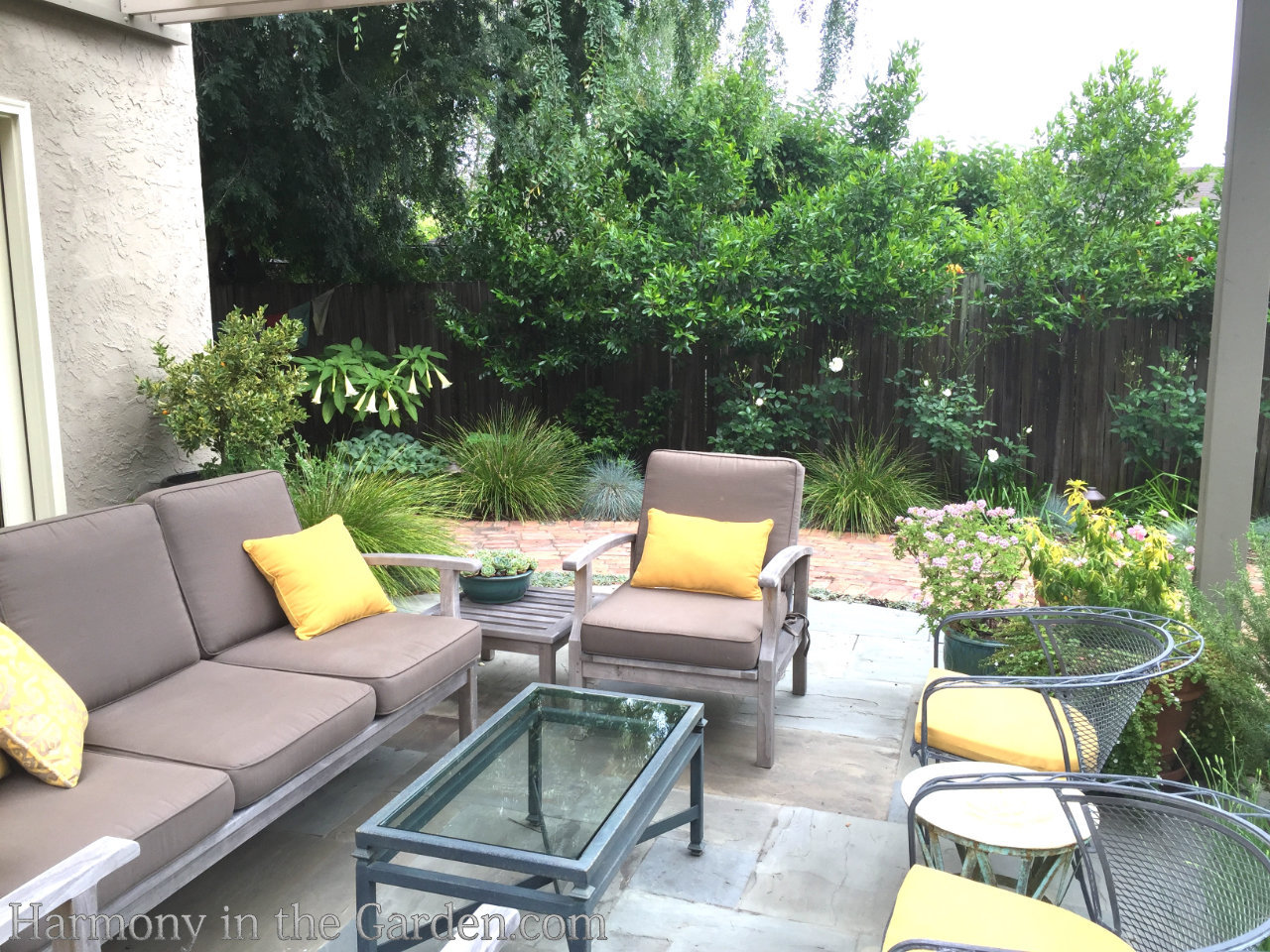

In this example, we used the ‘Bright ‘n Tight’ to block out the neighbor’s roofline. The above photo shows how it looked in year #1, while the left photo shows year #4.
Note the ‘Iceberg’ roses and grasses that are planted under the standard trees – all of this in about 2 ½’ of planting space!
Click here to see more about this garden’s amazing transformation.

When a neighbor added a second story close to the fence line, this homeowner’s privacy was shattered.
There wasn’t a trellis tall enough to block the view, so she planted a row of prunus caroliniana ‘Bright ‘n Tight’ that quickly transformed her view into a lush wall of green.
Surprisingly, the trees have fared well over the years despite receiving a hefty dose of shade (at least a half day’s worth in some parts of the skinny side yard.)
Take a peek below – the second story home is barely visible!

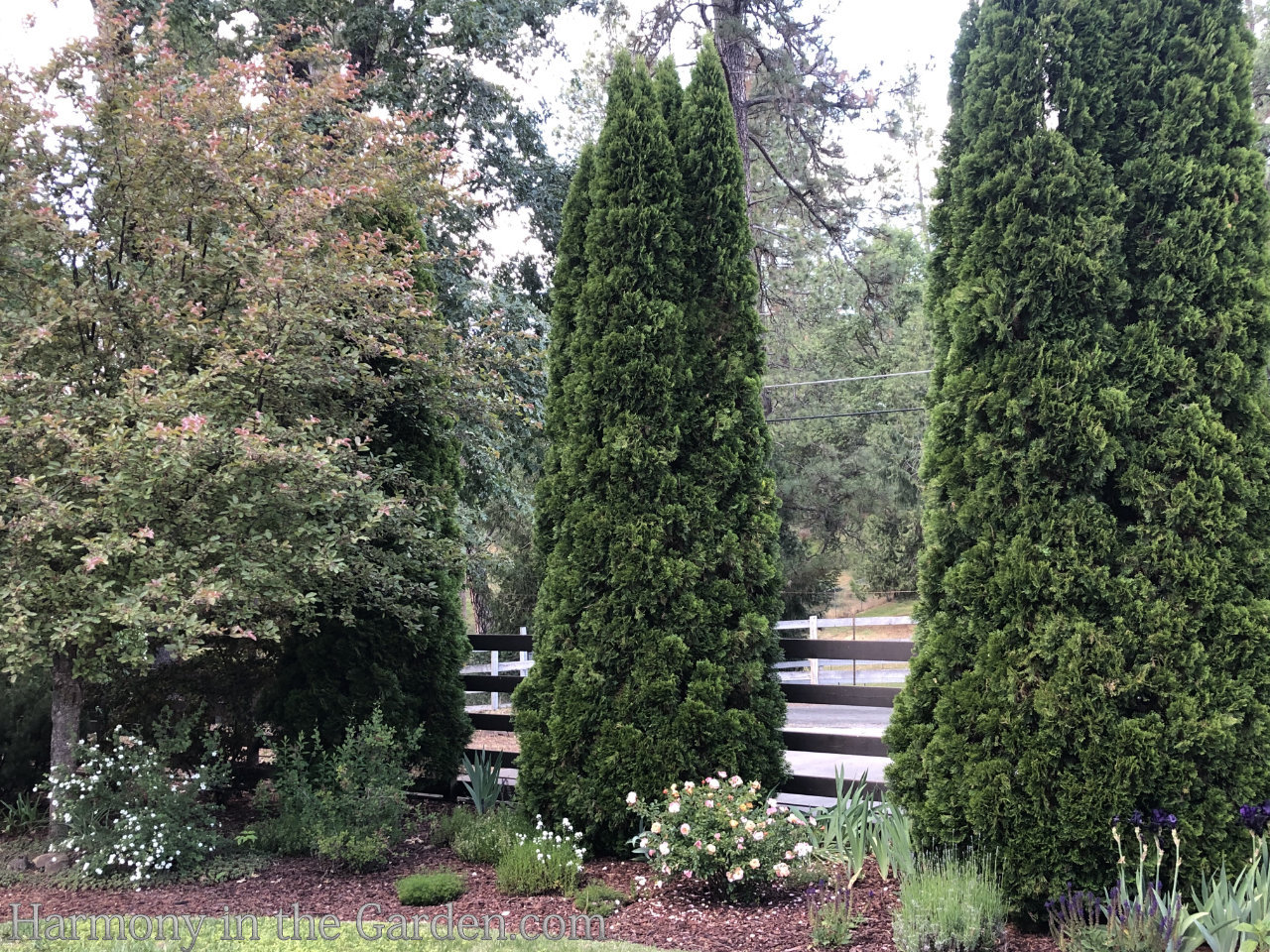
Similar to trellises and gates with open-lattice construction, sometimes a solid hedge isn’t needed to create a feeling of privacy.
In this instance, a solid row of thujas would have screamed ‘KEEP OUT!’ – definitely not welcoming to neighbors.
However, since plenty of space was left between the thujas, it’s friendlier as well as providing the perfect amount of screening.
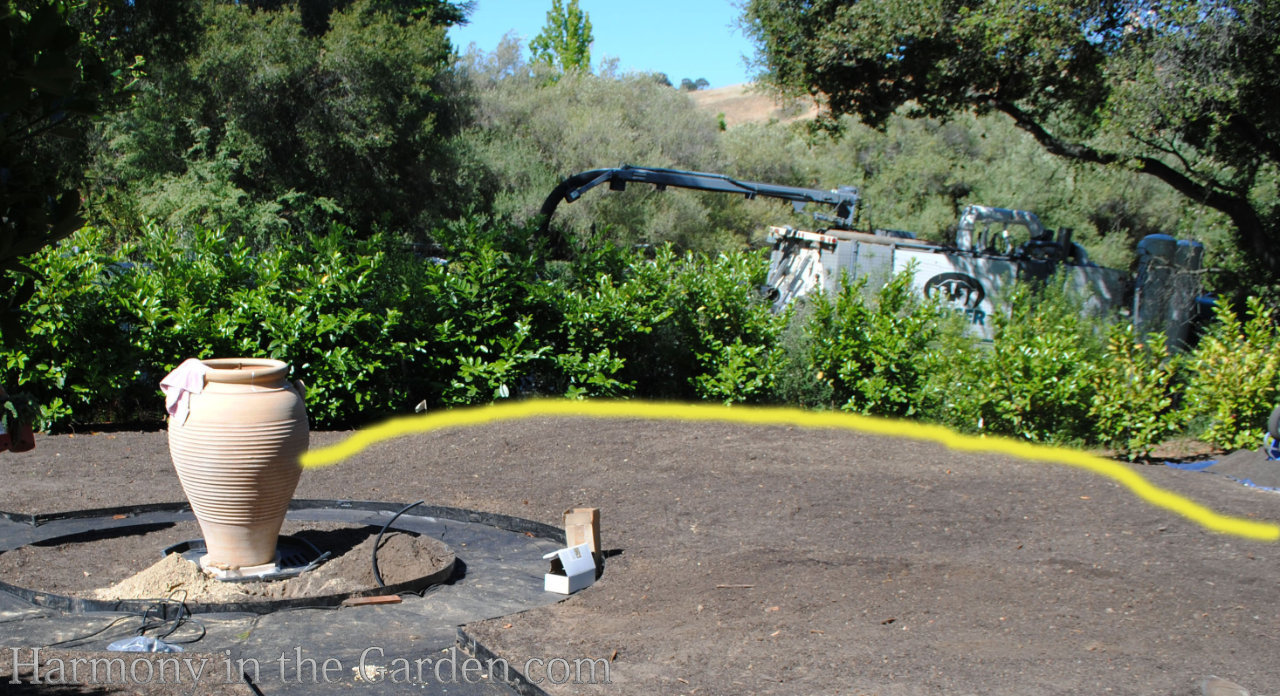
One of my favorite go-to strategies for creating privacy with plants, is to create a berm.
A berm helps give plants an additional ‘lift,’ adding a bit more height (and privacy) where needed, while remaining open and welcoming at the same time.
There are plenty of bad examples out there, where the berms are too high with too severe of a slope, looking like they fell out of the sky and plopped in the garden (I call them ‘berms gone bad!’)
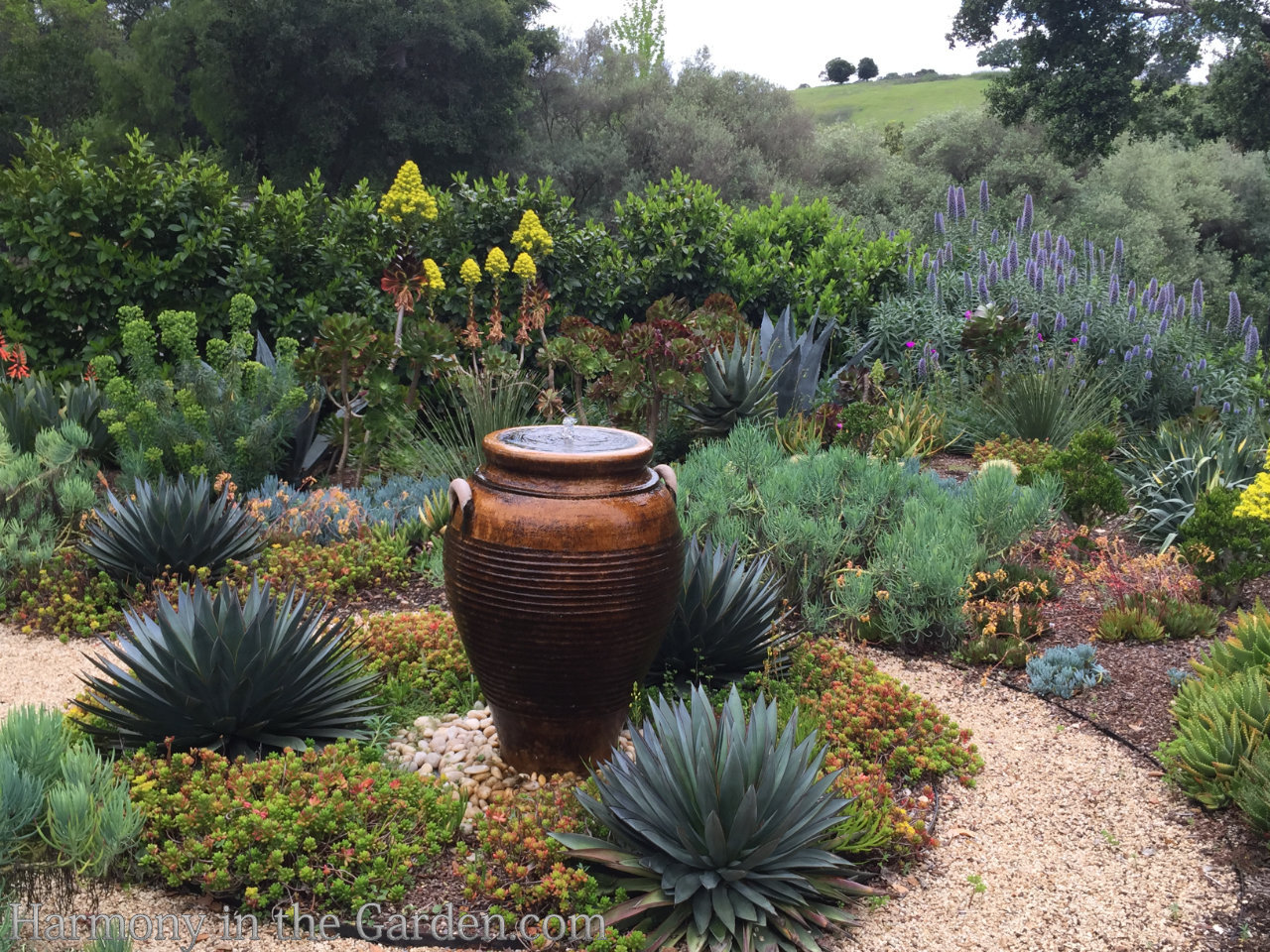
The key to to a successful berm is to keep it subtle.
I typically make berms no higher than 14” in the center, then gently taper them down to form a natural shape, like in the above photo.
You can see in the ‘after’ photo (left) that once planted, a natural barrier is created that not only blends with the rest of the garden but creates additional privacy where needed.

As I said, I create berms all the time in the gardens I design. Big gardens, small gardens, there’s almost always an opportunity for a berm.
This is my former front garden, which was relatively small. Without the berm, it would’ve been tricky to prevent the garden from looking flat.
But after the plants on the berm filled in the various heights add privacy (and interest!) to this small space.
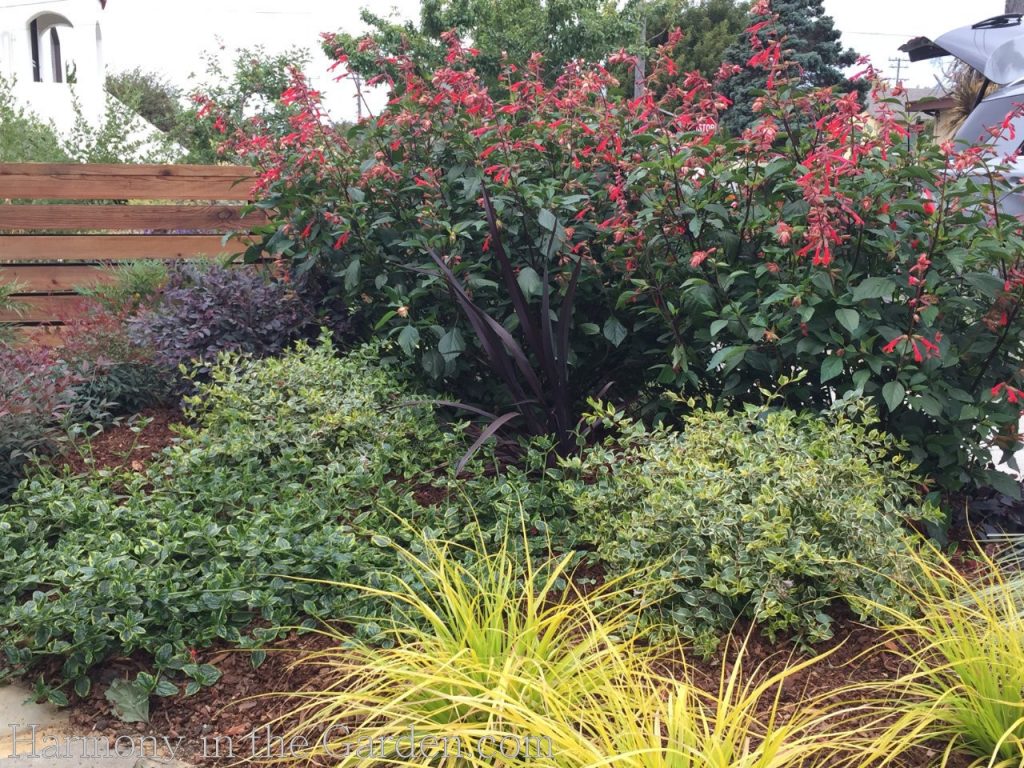
Here’s another example of a berm used in a very small garden, helping to provide interest and screening.
Click here to read more and to see some pretty great before-and-after photos.
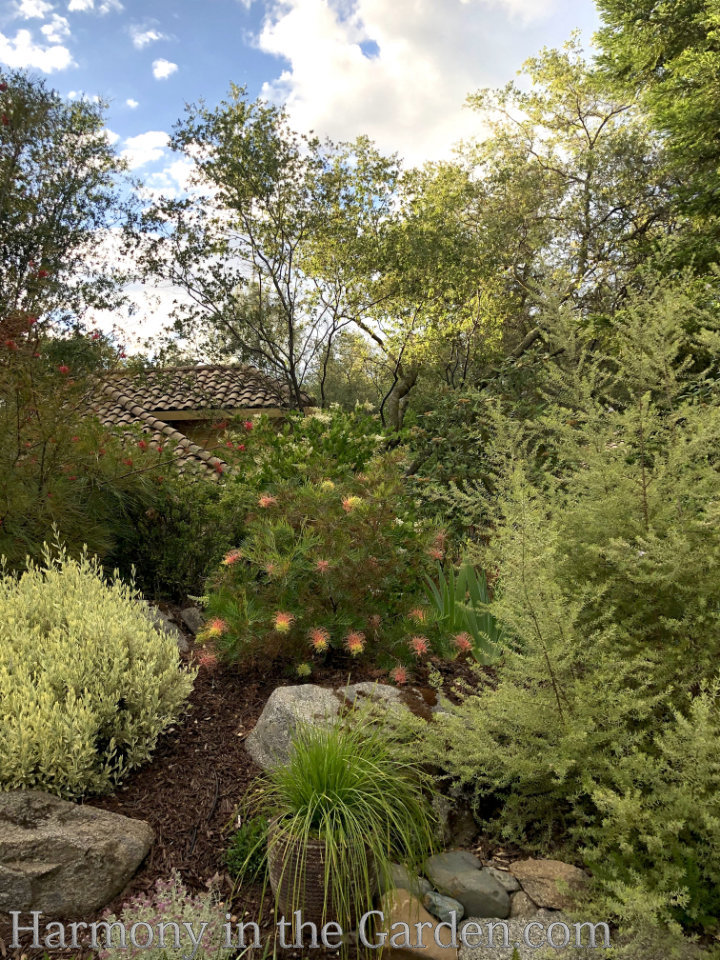
This is an example from my current garden, which shows my penchant for oversized, tall plants (in this case, grevilleas ‘Peaches ‘n Cream,’ ‘Long John,’ and a westringia ‘Morning Light’’.)
I used the height of these plants to my advantage to help screen the neighboring home. In case you missed my recent post about tall plants, click here.
And finally, for a deeper look into ways to create privacy in your garden, I highly recommend reading Mary Wingate’s fantastic book, Landscaping for Privacy.
As I read her book, I found myself not only agreeing with everything I read, but was inspired by innovative ideas from gardeners around the country. All in the name of creating their own private sanctuary.
I hope I’ve provided some inspiration for ways in which you can add privacy to your garden.
And If you have any favorite plants or screening ideas you’ve used in your own gardens, please share!






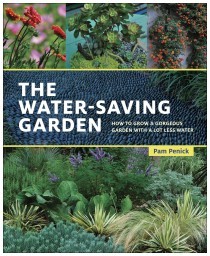
21 Comments
A new neighbor removed every living plant from his garden, including a tall hedge along the side yard. I planted white Iceberg roses along a portion of the front fence that has done well and grown quite tall. The neighbor cuts off anything hanging on his side and throws it over the fence. I am inspired by your suggested narrow free-standing trellises for the long remaining shared property line. Thank you for an excellent article.
You’re so welcome, Cara (I had a very similar neighbor at one point!) Those free-standing trellises are awesome and I hope they work for you.
Regarding Julie’s comment on invasive berry vines…..In my area, invasive Himalayan blackberry vines are regularly seen completely engulfing structures. They could very easily climb a tall trellis, and sheet mulching is completely ineffective at controlling them. The only way to get rid of them is to dig every last bit out of the soil, which is not always possible. I try not to use chemical controls, but sometimes there’s no other alternative. If a cane if poking through the fence, I will cut it down to a stub, then paint undiluted Round-up concentrate on that cut end. The most effective method I’ve found so far.
Thanks for your suggestion, Leia – I’m with you in that I try and never use poisonous chemicals but sometimes if used carefully it’s just about all a person can do – I have to do that with poison oak in my garden. I’ve tried every type of organic method out there and nothing else seems to work.
Love all your ideas and great photos.
Neighbor removes all the wonderful greenery? Why? But you solved the problem.
Thanks for sharing these helpful tips.
S
Why, indeed, Sharon. I asked myself that for years. 🙁
I always learn much from your articles. In this one, I like the free-standing L-shape trellis idea for something I’m dealing with: a troubling view of an elderly neighbor’s decrepit and messy shed that he’s plopped a pallet (covered in asphalt shingles) on top of the roof (I’m guessing he had a roof leak in the shed). Total height of nasty view is 12+ feet and he also has allowed invasive blackberries to escape his yard into mine, so the idea of planting something vining on lattice worries me; more structure for the thorny berry vines that I’m always cutting back seems counter-productive. Maybe sheet mulch under a berm will block berry runners, then a berm, then plants or trellis…TBD but you’ve given me some ideas. Thank you.
I’m so sorry, Julie, that you have such a crummy view AND have to deal with invasive thorny vines. Dang – that sucks. (btw: you’ve done a pretty awesome job describing your view – lol) I hope that L-shaped trellis works for you. I just love it in the courtyard and it seems like it’d be pretty hard for those blackberry vines to sneak up and over the trellis. Good luck!!!
Dear Rebecca: such an excellent article – thank you. I have wanted the 2 Clematis you mentioned but can’t source them ( I’m in Southern Marin County ). Any suggestions on where I could order Clematis cirrhosis ‘Wisley Creme’ and C. Avalanche? Diane Z.
Hi Diane, I’m glad you enjoyed the article! I’ve ordered the ‘Wisley Creme’ from Joy Creek Nursery, and they might also have ‘Avalanche.’ In the past, I’ve always found ‘Avalanche’ in retail nurseries in the Bay Area, and at Capitol Wholesale (which is where I order my plants for the gardens I design.) However, since this year is such a crazy year in terms of plant shortages, you might need to check with some of your local nurseries to see if they can special order it for you. Best of luck to you!!
An excellent post, Rebecca, and a great range of solutions. I love using berms to give that extra bit of height for quick screening and they can do double duty for the sharper drainage some plants need. I also find it’s a good way to give a plant picture a ‘back’.
Re screening out traffic noise, I recall learning years ago that you needed at least 5m (that’s about 15ft) depth to have much effect, and the denser the foliage, the better, such as multiple layers of very dense conifers. But unfortunately plants can’t make as much difference as a solid structure. I’ve seen one solution where local government rules would not allow a tall front solid fence where the owner installed a laminated glass fence set 1m (3ft) inside the front boundary that was hidden between two layers of screening shrubs.
Hi Catherine, thank you for the fantastic info re: traffic noise. I’ll ping Joan, below, to make sure she sees what you’ve written in hopes it can help her. And good point about the sharper drainage, too – my lavenders, euphorbias and grevilleas love those berms!
So many intriguing ideas in this article Rebecca. We need a screen to block views up the driveway to the shed, the firepit and potential hot tub area. We really need the driveway but need privacy as well. I’m thinking a portable trellis (on wheels) that can be moved whenever we need to drive to the shed area. Maybe Mary Wingate’s book would help as well. I really enjoy your blogs Rebecca. Thanks!
Hi Maia, a portable screen sounds like the perfect idea! In our book ‘Garden Up’ there was a photo in there of someone who had transformed the top part of their driveway into an area for plants, along with a screen. It was really sweet and I’ll try and find the photo to send to you. Hope all is well with you!
inspiring article Rebecca. We have just moved to the desert and while we have good privacy screening I’m wondering if there are any “noise absorbing” plants that we could grow in particular. to help with road noise that echoes. We do run fountains which helps but just curious if there are any particular plants that help block or absorb sound.
Oh gosh, that’s a good question, Joan! I’ve never heard of any specific plants that are great at absorbing noise, but I would imagine plants with dense and perhaps oversized foliage would be best. The thicker the better sort of concept? I just googled it and it seems there are a fair amount of articles saying the same thing (here’s one: https://gardengoodsdirect.com/blogs/news/best-plants-for-outdoor-sound-barriers) and while some of the plants wouldn’t thrive in your climate, I’m hoping there are some that would. Let me know what you come up with, I’m sure others would be interested to know!
Hello again, Joan, I just wanted to make sure you saw Catherine Stewart’s comment re: traffic noise. Hopefully you can find a solution using dense shrubs and trees that thrive in your desert climate!
Great post, Rebecca, and one I am particularly interested in as the very old dogwoods that have screened what I call my courtyard (front garden) are dying, as are others in the yard. Just had one cut down and the other might make it through this year but I am pretty sure that will be it. I love the way losing the first one opened up the garden but also mourn the sense of enclosure it gave when it was healthy. Now I have some ideas on how to get that back.
Oh, I’m so sorry to hear about your dogwoods, Barbara! Why is it that the things that tend to die in our gardens are the things we love the most – it’s never the plant you have mixed feelings about, is it. Hopefully the rest of the dogwoods will be just fine. I’m glad I gave you some ideas so you can at least plan ahead a bit. If you come up with something creative please let me know! I’m always looking for great ideas for screening!
Great article, thank you.
Thanks, Nicole – I’m glad you enjoyed it! 🙂